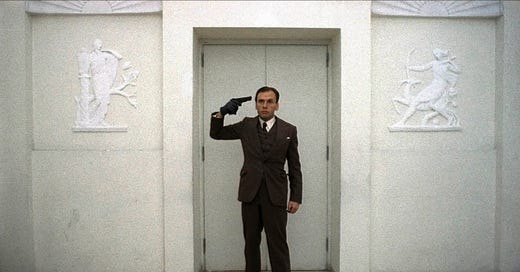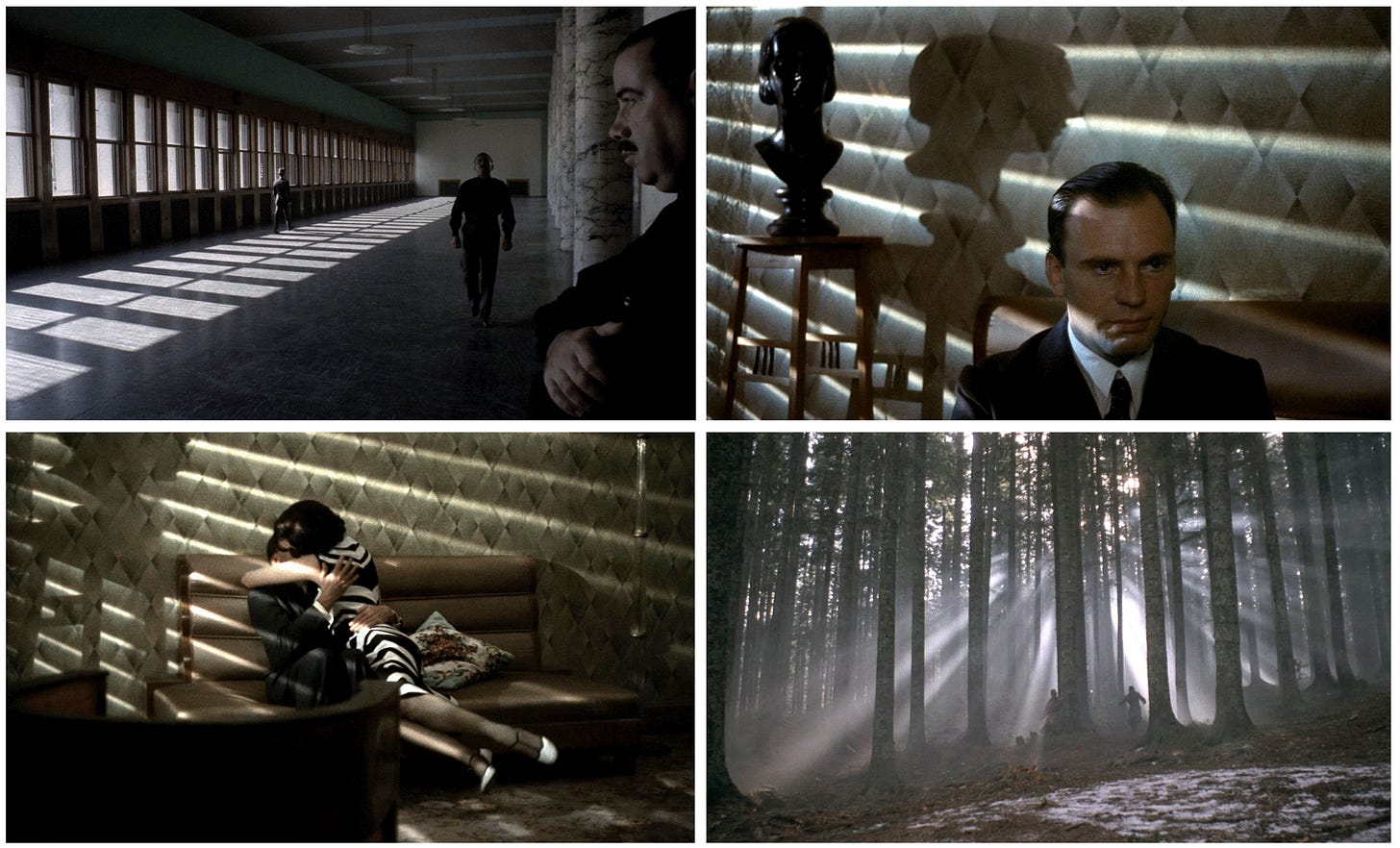Why do we conform?
Bernardo Bertolucci attempts to answer this question in his 1970s visual masterpiece The Conformist. A sensuous and sensual political thriller set in 1930s fascist Italy, the film explores the psychology of fascism and identity through the eyes, mind and experience of a stiff and emotionally unstable man wanting to belong.
Italian writer-director Bernardo Bertolucci (Last Tango in Paris, The Dreamers) adapted the 1951 novel by Alberto Moravia which resonates with Albert Camus’ L’Etranger (The Stranger) in its exploration of existential dread. The film quickly garnered international acclaim, thanks to its cinematic boldness, both narratively and visually - and stands today as one of the most influential films of all time, leaving an indelible mark on such filmmakers as Francis Ford Coppola and Martin Scorsese. It’s a must watch for any film lover, especially those who like morally ambiguous characters framed in a political and historical context (so, everyone, right?).
It stars the great Jean-Louis Trintignant as Marcello Clerici, as he flees the guilt of killing a man who sexually assaulted him when he was 12 years old. That escape takes many forms and shapes, notably through his deep desire to conform, to please, to accommodate, as well as a search for adequacy, normalcy, straightness. He will love and marry a normal girl, Giulia (Stefania Sandrelli), and will join the fascist party of his country. Sex and politics intertwine as he is asked to execute his old philosophy professor Quadri, now an outspoken antifascist exiled in Paris.
Psychologically visual
At first sight, the strength of the film lies in its cinematography and its narrative structure. Told in a series of flashbacks that defy cinematic linearity while staying true to a psychological linearity (how a memory triggers another and then another), The Conformist dares to crystalize the twisted connections made by Marcello’s neuroses, sometimes touching, sometimes shocking, always stunning.
This non-chronological storytelling is not present in the novel, and was not a part of the script, but rather came about in the edit room between Bertolucci and his editor Franco Arcalli. Not only does it showcase the importance of collaboration and serendipity in the filmmaking process, it elevates the genre into an existential questioning on trauma and guilt.
This feeling of guilt is only reinforced by the fluid and lightweight but daring camera-work, often translated by anxious angles, forced perspectives, “too much” headspace and inventive lighting.
In preparing this newsletter, I struggled to pick my favorite frames, each one more beautiful and complex than the next. This is thanks to the wonderful work of cinematographer Vittorio Storaro (who later went on to DP Apocalypse Now) and art director Ferdinando Scarfiotti who have crafted impressive fascist-era sets through the authentic architecture of Rome’s Mussolini-era brutalist EUR district.
Let them see the light
In these modern buildings, the light comes through fragmented and stressful - the opposite of hopeful. It still creates emotion, spectacle, suspense, and, in key scenes, reinforces Marcello’s troubled psyche and moral ambiguity. The result is gleaming and dynamic, always keeping you on your toes wondering what shot will come next.
Additionally, Bertolucci and Storaro use rich colors symbolically. Some scenes are fully red, orange, or blue - each representing a mood or a feeling, forcing you to feel something, or everything. What, in particular? That’s really up to you.
Indeed, there is a certain ambiguity in The Conformist - morally, sexually, politically. You’re never really sure what to feel. A stiff and unlikable protagonist who will do anything to be what he considers “normal” (including committing the most monstrous and violent acts) is not redeemed or justified by the total violence he has lived through as a child.
It is not as simple as good vs. evil or fascist vs. antifascist. Bertolucci takes you on a maze-like journey of identity through the lens of what it means to be a fascist: the complete denial of the self for the sake of the totalitarian, authoritarian group; the repression of identity and individuality to conform; the violence.
Marcello is so embedded in this desire to conform that he relents all of his being to the norm and to the state. Not out of ambition or ideology, but out of fear, discomfort, otherness, and by repressing his childhood trauma of assault, homosexuality and shame. His intellect, his education, his poise - all disappear for the purpose of blending in, fitting in. It goes as far as him using his honeymoon as a pretext to go to Paris, on the secret police’s assignment to kill his former professor.
It is in Paris that Marcello’s true colors come out: he cannot spy on professor Quadri, he cannot kill him, he even falls in love with Quadri’s wife Anna (played by the haunting Dominique Sanda), who herself falls in love with Giulia.
But Marcello doesn’t stop himself in his assassination attempt out of morality, but rather because of his deep cowardice. He cannot make a choice between good and evil because that would mean asserting himself.
When sex meets politics
Very quickly, we witness the interwoven link between sex and politics. A question of power and complexity, sex is used as a way to exert power and to seduce, but also to blur the lines. The fact that Bertolucci always comes back to it in this fascist-era political thriller is telling of all sex’s virtues and faults - thrilling, always; liberating, sure; eye-opening, never.
In The Conformist, there is a daring and beautiful example of sexual fluidity in Anna’s character. As she falls in love with Giulia, together they perform one of the most sensual tango scenes of cinematic history in front of Marcello and Quadri. Marcello wants to stop them, but Quadri applauds their sheer beauty. It’s true that they are beautiful.
Their iconic dance starts off as innocent, liberating, sensual but quickly transforms into a claustrophobic episode for Marcello, who is suddenly surrounded by the dancers, unable to escape or to reach out for air. And things take a turn after that. Expect anything - and specifically a harrowing climax that continues to haunt me, even days later.
In the space of a few minutes in the Parisian dance hall, so many emotions run through the audience’s mind - and that experience sums up the entire film for me: a whirlwind of visuals, feelings, and interpretations that warrant a second, third and even fourth viewing. I’ll therefore apologize if I didn’t mention certain themes or characters. There is simply too much to say.
It’s your turn, then, to discern what the film means. The Conformist is available to rent wherever you rent movies.
Further reading, watching, listening
For my French speakers, a little vignette from my favorite YouTube channel Arte’s Blow Up on why you should watch The Conformist.
For my interested English speakers, a comprehensive obituary of Bernardo Bertolucci on the Criterion Collection’s wonderful essay-blog The Current.
A detailed article noting the influence The Conformist had on American cinema of the 1970s - mainly on Italian-American directors Scorsese and Coppola, and therefore on everyone else that came after.
I was writing this week’s newsletter with appropriate, cinematic beats, curtesy of The Offline’s album La couleur de la mer. Highly recommend.
“I guess I’ll see you in the movies.”










Funny, I saw this film probably six times in my life. We’re probably of the same generation.